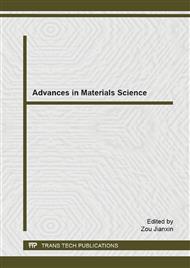[1]
P.M. Adler, M.C. Campo, J. Caro, et al., Nanoporous materials: advanced techniques for characterization, modeling, and processing, in: N. Kanellopoulos, Boca Raton, US: CRC Press / Taylor & Francis Group, 2011, p.578.
Google Scholar
[2]
J. Zhang, C. V Li., Nanoporous metals: fabrication strategies and advanced electrochemical applications in catalysis, sensing and energy systems, Chem. Soc. Rev. 41(21) (2012) 7016-7031.
DOI: 10.1039/c2cs35210a
Google Scholar
[3]
J. Erlebacher, I. McCue, Geometric characterization of nanoporous metals, Acta. Mater. 60(17) (2012) 6164-6174.
DOI: 10.1016/j.actamat.2012.07.059
Google Scholar
[4]
H. Qiu, X. Dong, X. Huang, Design of nanoporous metals with bimodal pore size distributions for enhanced biosensing, Nanoscale. 4 (2012) 4492-4497.
DOI: 10.1039/c2nr30460k
Google Scholar
[5]
M.F. Sarac, P. Shimpi, J.A. Mackey, D.S. Kim, P. -X. Gao, Surface dezincification and selective oxidation induced heterogeneous semiconductor nanowire/nanofilm network junctions, Cryst. Growth. Des. 10(9) (2010) 3942-3948.
DOI: 10.1021/cg100486g
Google Scholar
[6]
M. Tiemann, Porous metal oxides as gas sensors, Chemistry-A European Journal. 13(30) (2007) 8376-8388.
DOI: 10.1002/chem.200700927
Google Scholar
[7]
S. Mridha, D. Basak, Investigation of p-CuO/n-ZnO thin film heterojunction for H2 gas-sensor applications, Semicond. Sci. Tech. 21(7) (2006) 928-932.
DOI: 10.1088/0268-1242/21/7/017
Google Scholar
[8]
L. Sun, C. -L. Chien, P.C. Searson, Fabrication of nanoporous nickel by electrochemical dealloying, Chem. Mater. 16(16) (2004) 3125-3129.
DOI: 10.1021/cm0497881
Google Scholar
[9]
M. Hakamada, Y. Chino, M. Mabuchi, Nanoporous surface fabricated on metal sheets by alloying/dealloying technique, Mater. Lett. 64(21) (2010) 2341-2343.
DOI: 10.1016/j.matlet.2010.07.046
Google Scholar
[10]
J.X. He, S. Baharani, Y.X. Gan, Processing and electrochemical property characterization of nanoporous electrodes for sustainable energy applications, Research Lett. in Nanotechnol. Article ID 313962 (2009) 5p.
DOI: 10.1155/2009/313962
Google Scholar
[11]
C.L. Liao, C.W. Chu, K.Z. Fung, I.C. Leu, Fabrication of nanoporous metal electrode by two-step replication technique, J. Alloy Compd. 441(1-2) (2007) L1-L6.
DOI: 10.1016/j.jallcom.2006.09.084
Google Scholar
[12]
N.L. Kazanskiy, S.P. Murzin, Ye.L. Osetrov, V.I. Tregub, Synthesis of nanoporous structures in metallic materials under laser action, Opt. Laser. Eng. 49(11) (2011) 1264-1267.
DOI: 10.1016/j.optlaseng.2011.07.001
Google Scholar
[13]
S.P. Murzin, N.L. Kazanskiy, Creation of metal materials nanoporous structures under the action of laser radiation, ALT Proceedings. 1: DOI: 10. 12684/alt. 1. 43 (2012) 5p.
DOI: 10.12684/alt.1.43
Google Scholar
[14]
S.P. Murzin, Exposure to laser radiation for creation of metal materials nanoporous structures, Opt. Laser Technol. 48 (2013) 509-512.
DOI: 10.1016/j.optlastec.2012.11.031
Google Scholar
[15]
S.P. Murzin, Method of composite nanomaterials synthesis under metal/oxide pulse-periodic laser treatment, Computer Optics. 38(3) (2014) 469-475.
DOI: 10.18287/0134-2452-2014-38-3-469-475
Google Scholar
[16]
S.P. Murzin, V.I. Tregub, A.A. Melnikov, N.V. Tregub, Application of radiation focusators for creation of nanoporous metal materials with high specific surface area by laser action, Computer Optics. 37(2) (2013) 227-233.
DOI: 10.18287/0134-2452-2013-37-2-226-232
Google Scholar
[17]
S.P. Murzin, V.I. Tregub, E.V. Shokova, N.V. Tregub, Thermocycling with pulse-periodic laser action for formation of nanoporous structure in metal material, Computer Optics 37(1) (2013) 99-104.
DOI: 10.18287/0134-2452-2013-37-1-99-104
Google Scholar
[18]
S.P. Murzin, Synthesis of metal materials nanoporous structures with cyclic elasto-plastic deformation under laser treatment using radiation focusators, Computer Optics. 38(2) (2014) 249-255.
DOI: 10.18287/0134-2452-2014-38-2-249-255
Google Scholar
[19]
P. Strunz, D. Mukherji, J. Saroun, U. Keiderling, J. Rösler, Pore structure characterization and in-situ diffusion test in nanoporous membrane using SANS, Conference Series 247 (2010) 012023, 8p.
DOI: 10.1088/1742-6596/247/1/012023
Google Scholar
[20]
D. Mukherji, J. Lackne, N. Wanderka, N. Kardjilov, O. Näth, S. Jäger, F. Schmitz, J. Rösler, Coating of meso-porous metallic membranes with oriented channel-like fine pores by pulsed laser deposition, Nanotechnology 19(6) (2008) 065706, 8p.
DOI: 10.1088/0957-4484/19/6/065706
Google Scholar
[21]
H. -J. Jin, J. Weissmüller, Bulk nanoporous metal for actuation, Adv. Eng. Mater. 12(8) (2010) 714-723.
DOI: 10.1002/adem.200900329
Google Scholar


